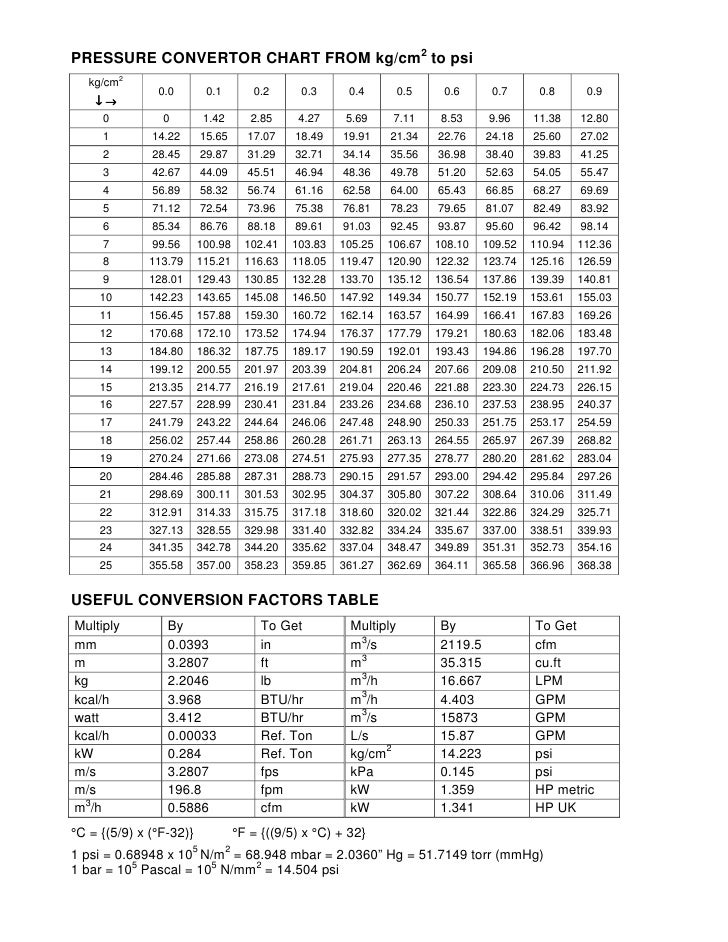

free apps for offline use on mobile devices. There are 1000 millibar (mbar) in one bar, a unit common in meteorology and weather applications.ġ millibar = 0.001 bar = 0.750 torr = 100 Paĭownload kPa to bar, psi, mmH2O and inH2O chart Related Mobile Apps from The Engineering ToolBox One bar is 100,000 Pa, and for most practical purposes can be approximated to one atmosphere even if The bar (bar) is commonly used in the industry. We assume you are converting between pound/square inch gauge and bar.You can view more details on each measurement unit: psig or bar The SI derived unit for pressure is the pascal. Since atmospheric pressure is 14.696 psi - a column of air on a area of one square inch area from the Earth's surface to the space - weights 14.696 pounds. More information from the unit converter. but is now replaced in almost every country except in the US by SI units. Pounds per square inch (psi) was commonly used in the U.K.

The temperature of 293 oK (20 oC) is sometimes used. The Standard Atmospheric Pressure is defined at sea-level at 273 oK (0 oC) and is 1.01325 bar or 101325 Pa (absolute). The Standard Atmospheric Pressure ( atm) is normally used as the reference when listing gas densities and volumes. The atmospheric pressure varies with temperature and altitude above sea level. This pressure is often called the gauge pressure and can be expressed asĪtmospheric pressure is the pressure in the surrounding air at - or "close" to - the surface of the earth. Gauge PressureĪ gauge is often used to measure the pressure difference between a system and the surrounding atmosphere. All calculations involving the gas law requires pressure (and temperature) to be in absolute units. The absolute pressure - p abs - is measured relative to the absolute zero pressure - the pressure that would occur at absolute vacuum. The basic unit for mass is slug and the unit for force is pound ( lb) or pound force ( lb f). P = pressure (lb/in 2 (psi), lb/ft 2 (psf), N/m 2, kg/ms 2 (Pa))ġ) In the Imperial - English Engineering System special care must be taken for the force unit. The equation for pressure can be expressed as: Feel free to contact us for any feedback."the normal force per unit area exerted on a imaginary or real plane surface in a fluid or a gas" Lenntech BV is not responsible for programming or calculation errors on this sheet. The constant c is equal to the amount of gas in moles, multiplied by the gas constant: These conditions are often fullfilled, for example for air at atmospheric pressure and standard temperature. This formula is called the ideal gas law.It is valid if the temperature (in kelvin) is at least 50% higher than the temperature at the critical point and the pressure does not exceed the critical pressure. This is because the molecules get more energy and move faster.Ĭ is a constant, proportional to the number of gas molecules If the volume is constant and the temperature increases, the pressure also increases. The pressure of a gas is related to temperature and volume. Relation between temperature, pressure and volume (ideal gas law):

If you measure the pressure in Pascal at sea-level, you will find 101325 Pa. At sea-level the pressure is also defined as 1 atmosphere, that's why 1 atmosphere equals 760 torr. It was calibrated that on sea-level the height of the mercury was 760 mm. The reason that mercury is used is that the thermal expansion of mercury is big and is mostly homogeneous. If the pressure changes, the level of the mercury in the tube changes with it. The unit of pressure used to be torr, also known as mmHG (millimeter mercury). The unit is Pascal (Pa), also known as N/m 2. Pressure ( p) is a derived quantity with its own name. Use this conversion calculator to convert American/Britis units to the metrical (SI) units. Separation and Concentration Purification Request.Plant Inspection & Process Optimalisation.


 0 kommentar(er)
0 kommentar(er)
